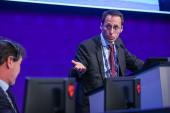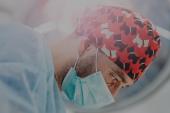PCI No Better Than GDMT in Ischemic Cardiomyopathy: REVIVED-BCIS2
PCI should not be undertaken to treat and improve left ventricular dysfunction, says Divaka Perera.

BARCELONA, Spain—Coronary revascularization with PCI fails to provide any additional benefit beyond guideline-directed medical therapy (GDMT) in patients with severely impaired left ventricular function and extensive coronary artery disease, results from a new randomized trial show.
In REVIVED-BCIS2, which was presented today during a Hot Line session at the European Society of Cardiology (ESC) Congress 2022 and published in the New England Journal of Medicine, investigators observed no difference in the primary endpoint of death from any cause or hospitalization for heart failure (HF) in those treated with medical therapy and those undergoing PCI.
“Although there is no evidence to support it, percutaneous coronary intervention is frequently undertaken to treat and improve left ventricular dysfunction,” lead investigator Divaka Perera, MD (King’s College London, England), told the media during a press conference announcing the results. “The key take-home message [from REVIVED], where I’m concerned, is that this is now a definitive result. We finally have [randomized, controlled trial] evidence to allow the guidelines to be strengthened on the one hand and for clinical practice to be rationalized around the world on the other.”
In the ESC guidelines, CABG is recommended as the first revascularization strategy in patients with ischemic cardiomyopathy and multivessel disease as long as the risk of surgery is acceptable (class I, level of evidence B). PCI can be considered in one- or two-vessel disease when complete revascularization can be achieved (or in three-vessel disease based on advice from the heart team), although that recommendation is relatively weak (class IIa, level of evidence C). In the US, surgery is also recommended for these patients, but there is no direction given on the use of PCI because of the lack of data.
The 700-patient REVIVED-BCIS2 trial was intended to address the evidence gap. It was launched in the shadow of the Surgical Treatment for Ischemic Heart Failure (STICH) trial, a study that showed revascularization could improve the very long-term outcomes in this complex patient population. While the 5-year results of STICH didn’t show any benefit of CABG over medical therapy, a survival advantage with surgery emerged by 10 years. It had been hoped that less-invasive PCI might be equally effective as surgery in reducing mortality, as well as HF hospitalizations, in patients with severe ventricular dysfunction and extensive coronary artery disease.
“We wanted to see if we could deliver revascularization more safely and still provide the patient benefits,” said Perera. “That [isn’t] the case.”
The key take-home message [from REVIVED], where I’m concerned, is that this is now a definitive result. Divaka Perera
Eric Velazquez, MD (Yale School of Medicine, New Haven, CT), who led the STICH trial, praised the investigators, noting that REVIVED provides evidence in a “data-free zone.”
“There has been a natural extension, maybe through the laws of transference, that the STICH trial results could or should be applicable to PCI in similar patients,” he told TCTMD. “Obviously, we didn’t study PCI so it’s a leap of faith. The REVIVED study will make people think twice about taking that view.”
Mary Norine Walsh, MD (Ascension St. Vincent Heart Center, Indianapolis, IN), who wasn’t involved in the trial, said the results aren’t too surprising based on the primary 5-year results from STICH, but also because the HF field has changed since that trial first randomized patients in the early 2000s.
“Our guideline-directed medical therapy for patients with [heart failure with reduced ejection fraction]—or left ventricular dysfunction because some of these patients were asymptomatic—is better now,” Walsh told TCTMD, citing the development of an angiotensin receptor neprilysin inhibitor (ARNI) and sodium-glucose cotransporter 2 (SGLT2) inhibitors as new drug classes with proven efficacy.
“The hashtag that’s going around Twitter all the time now is #GMDTworks,” she said. “And it does. This is further proof that guideline-directed medical therapy helps patients.”
Eligibility for Randomization
Patients eligible for randomization in REVIVED had a left ventricular ejection fraction ≤ 35% and extensive coronary artery disease as assessed by the British Cardiovascular Intervention Society (BCIS) jeopardy score. With PCI, the treatment protocol required operators to attempt revascularization in all diseased proximal coronary vessels subtending four or more areas of viable myocardium. Medical therapy was managed by HF specialists at the recruiting centers and included not only GDMT titrated to optimal doses but also use of medical devices, such as ICDs with and without cardiac resynchronization therapy.
After a median follow-up of 3.4 years, the primary endpoint—a composite of all-cause mortality and HF hospitalizations—occurred in 37.2% of patients in the PCI arm and 38.0% of patients in the medical-therapy group, a nonsignificant difference. There was no difference in the risk of individual components of the primary outcome, nor any difference in the risk of acute MI. Spontaneous MIs, however, were more frequent with medical therapy and the risk of unplanned revascularization was significantly higher (2.9% with PCI vs 10.5% with medical therapy; HR 0.27; 95% CI 0.13-0.53).
Quality of life, assessed by the Kansas City Cardiomyopathy Questionnaire (KCCQ), tended to favor PCI at 6 months, but there was no significant difference between the two strategies at 2 years, attributable to gradual catch-up in the medical therapy group over time. Left ventricular ejection fraction—which was 27.0% in both treatment arms at baseline—was no different between the two treatment approaches at 6 and 12 months.
At first blush, I do think that the results are disappointing. Ajay Kirtane
Speaking with TCTMD, Perera highlighted several differences between STICH and REVIVED, noting that surgery in the earlier STICH trial was associated with an early excess risk of mortality, with nearly a threefold higher risk of death at 30 days compared with GDMT. In REVIVED, there was no early mortality signal with PCI, such that the “event curves were absolutely superimposed all the way through [follow-up],” he added. In all the prespecified subgroups, even when focusing on patients with the most-severe CAD, they saw no hint of benefit with PCI. Finally, Perera noted that STICH only randomized patients considered optimal surgical candidates. The mean age of patients in that trial was 59 years, whereas REVIVED enrolled a more “real-world population” with a median age of 70 years.
“It’s apples and oranges,” he said. “It’s hard to compare the trials.”
To TCTMD, Velazquez also noted that patient selection differed between the two trials, with REVIVED only selecting those with viable myocardium. The presence of viable myocardium, regardless of treatment, identifies patients at lower risk, and there are data showing that GDMT can improve contractile function in viable segments independent of revascularization.
“This concept that viability requires revascularization above and beyond medical therapy is something that these authors addressed point-blank and the results suggest this is not the case,” he said. “I am not personally surprised, because we’ve seen that now before. In STICH, we have pretty consistently shown that the benefits of CABG versus medical therapy were not related to viability and that viability was not really a major parameter that could define patients who would have more or less survival benefit with CABG. That’s been controversial, but it’s been shown.”
There has been a natural extension, maybe through the laws of transference, that the STICH trial results could or should be applicable to PCI in similar patients. Eric Velazquez
What was a little surprising, said Velazquez, is that there was no difference in the risk of acute MI or hospitalizations for HF. PCI and CABG are different revascularization procedures, with CABG providing more global protection across the myocardium.
“If we focus only on the flow-limiting lesions, you might not have the opportunity to reduce subsequent MIs that are more likely to occur in non-flow-limiting lesions,” said Velazquez. “It’s more about atherosclerotic burden than on an individual lesion when it comes to the long-term benefits of the revascularization approaches.”
Velazquez also pointed to the high risk of death in this patient population, noting that it was more than two times the rate of hospitalization for HF. It suggests that these patients with extensive CAD and left ventricular dysfunction don’t have sufficient ischemic reserve to survive a clinical event, such as an MI, said Velazquez.
Complex CAD Assessed by BCIS Score
In clinical practice, Walsh said, physicians will assess both myocardial viability and ischemia in patients who have heart failure with reduced ejection fraction (HFrEF) and multivessel CAD to determine if they might be candidates for revascularization with surgery. She pointed out that the vast majority of PCI-treated patients (77%) in REVIVED had NYHA class I/II symptoms, a group that does very well with GDMT. She also noted that 88% of people randomized in the trial were men.
“They didn’t enroll women, but there are clearly women with ischemic cardiomyopathy,” said Walsh.
Ajay Kirtane, MD (NewYork-Presbyterian/Columbia University Irving Medical Center, New York, NY), who wrote an editorial accompanying the study, also highlighted differences between STICH and REVIVED, noting that STICH was a larger trial with all-cause mortality as the primary endpoint. In addition to the observed benefit with revascularization in the longer-term follow-up in STICH, Kirtane noted that a subanalysis from ISCHEMIA hinted that the invasive strategy with revascularization was superior to medical therapy in a small number of patients with HF or left ventricular dysfunction.
“On the heels of those studies, many people might have hoped that REVIVED would be positive and that we could achieve similar results with PCI,” Kirtane told TCTMD. “At first blush, I do think that the results are disappointing.”
Still, he highlighted the relatively short follow-up in REVIVED at 3.4 years, noting that it took a decade for CABG to reduce the risk of all-cause mortality in this patient population. Additionally, the reduction in spontaneous MIs favors PCI and requires further scrutiny, he said, noting that follow-up will determine if those events translate into long-term differences in outcomes. There is also a need for more information about the anatomical location/extent of CAD and its correlation with physiological and ischemic testing. Encountering REVIVED-like patients is common in clinical practice, so it’s important to tease out whether the CAD is coincidental to or responsible for the LV dysfunction, said Kirtane.
The hashtag that’s going around Twitter all the time now is #GMDTworks. Mary Norine Walsh
Perera agreed with that assessment, noting they’ve only had access to the unblinded data for just a few weeks. In time, they plan to present more granular procedural data, including the relationship between the coronary stenosis with previous myocardial viability testing.
While Kirtane stated that patients in REVIVED appeared to only have a “modest” degree of CAD considering the extent of left ventricular dysfunction, Perera disagreed with that characterization. The BCIS jeopardy score, he said, provides a very detailed snapshot of overall disease severity, noting that the median score was 10 out of 12.
“Twelve means the entire myocardium is perfused with coronary arteries that are severely diseased,” said Perera. “Ten is a pretty high score. We also included patients with left main coronary disease, something that’s never been done in any randomized trial where one arm is medical therapy. ISCHEMIA excluded left main patients, STICH excluded left main patients, but 100 of our 700 patients had left main disease. So, actually, this was a population with severe coronary artery disease.”
Michael O’Riordan is the Managing Editor for TCTMD. He completed his undergraduate degrees at Queen’s University in Kingston, ON, and…
Read Full BioSources
Perera D, Clayton T, O’Kane PD, et al. Percutaneous revascularization for ischemic left ventricular dysfunction. N Engl J Med. 2022;Epub ahead of print.
Kirtane AJ. REVIVE-ing a weak heart—details matter. N Engl J Med. 2022;Epub ahead of print.
Disclosures
- Perera reports grant support from and serving on a scientific advisory board for Abbott Vascular, grant support from Maquet Cardiovascular, and speaker fees from Philips.
- Kirtane reports institutional funding to his institution and/or Cardiovascular Research Foundation from Abbott Vascular, Boston Scientific, Abiomed, CathWorks, Siemens, Philips, ReCor Medical, Cardiovascular Systems Incorporated, Chiesi, Amgen, Neurotronic, Bolt Medical, Biotronik, Magenta Medical, Canon, SoniVie, Shockwave Medical, and Merck. He reports nonfinancial support/personal fees/other from Abbott Vascular, Boston Scientific, Abiomed, CathWorks, Siemens, Philips, ReCor Medical, Cardiovascular Systems Incorporated, Chiesi, OpSens, Zoll, Regeneron, IMDS, Amgen, Neurotronic, Bolt Medical, Biotronik, Magenta Medical, Canon, SoniVie, Shockwave Medical, and Merck.





Comments